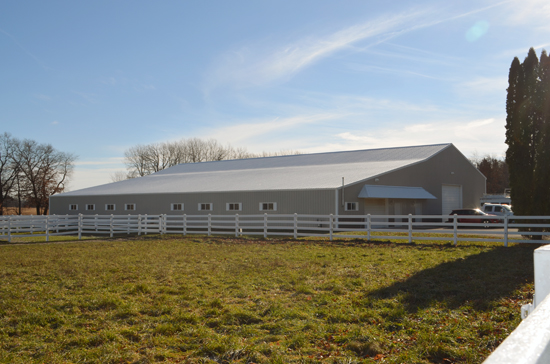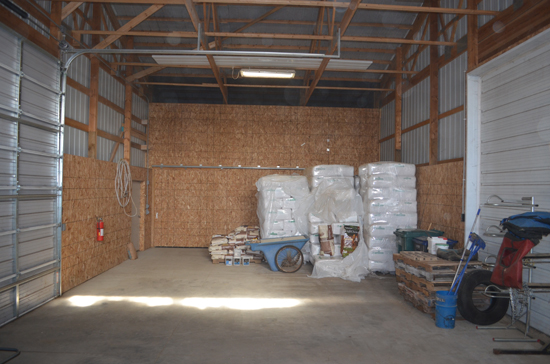
Firefighter spraying water from hose on fully envolved barn fire. Night time shot.
The National Fire Protection Association (NFPA) estimates that from 2006 to 2010 there were 830 structural fires in barns and other livestock facilities, causing an estimated $28 million in direct property damage. In addition to the loss of farm buildings, agricultural equipment, and livestock, one person died and 10 others were injured in these fires.
It’s a tragedy with which Wisconsin trainers Rhonda and Larry Spratto are unfortunately all too familiar.
In May 2012 lightning struck their barn sparking a fire that killed 13 horses and burned their barn to the ground.
“The whole thing was like a bad dream,” says Larry Spratto,” “and the hardest thing was having to call 13 families and tell them their horse had died.”
The Spratto barn was equipped with a lightning rod but it proved no match for the severe and fast moving storm that pummeled the Pickett area early that morning. The strike melted the rod, hit the transformer and the power box in the barn.
“It looked like someone had dropped a bomb,” Larry says. “It was not a slow burning fire. It went up fast.”
The Sprattos had taken necessary steps to protect their facility but when they finally decided to rebuild and continue their training operation they paid even closer attention to protecting their new structure. They built a separate room on the front of the barn to store shavings and hay, far away from the stalls, met with their local fire marshall to discuss how to make it as safe as possible and how many fire extinguishers were needed.

An outside look at the new barn built by Larry and Rhonda Spratto
“We upgraded all electrical equipment, including outlets, switch plates and all wiring is in heavy conduit,” Larry explains. “Nothing is exposed and it’s all industrial strength.”
He says you can’t do enough to protect yourself and encourages others to take a close look at their own facilities.
The NFPA reports that barn fires are more common during the colder months of the year, peaking in January, so now is a perfect time to evaluate the safety of your own facility.
Laurie Loveman, Chagrin Falls, Ohio, an expert in barn safety who is also a firefighter, has dedicated much of her life to helping people prevent barn fires. Loveman, an avid horsewoman, is a member of the National Fire Prevention Association (NFPA) Technical Committee on Fire Safety in Animal Housing Facilities.
For several years she has been keeping statistics on barn fires, their causes and their devastating consequences. Loveman says she believes that horse owners can buy precious time with their horses by carving out a small amount of time to develop fire prevention and emergency evacuation plans.
“Fire prevention, for the most part, consists of practices, the things we do on a day-to-day basis to maintain a fire-safe building. Knowing fire propagation requirements will help you to keep an eye out for possible hazards,” she says.

The new Spratto barn has a separate room for hay, bedding and feed and all wiring is in heavy conduit.
Smoking Taboo
The first thing to prohibit under every circumstance, she says, is smoking. “Stringently enforce the No Smoking rule, not just by posting signs, but by firmly telling a smoker to refrain,” she says. Barn owners who do not rigorously enforce this rule may find that they’ve inadvertently invalidated their insurance policies.
Cobwebs A Danger
Loveman says that brooms and rakes are two of the best fire prevention tools available to barn owners. “Get rid of cobwebs hanging from the rafters,” she says. Even though cobwebs are persistent—they seem to grow back over night—keeping after them robs fire of an easy pathway to spread throughout a barn. “Cobwebs provide excellent pathways along which flame can travel–so quickly that in seconds fire will have spread from one end of the barn to the other. In addition, flaming pieces of cobwebs falling into stalls will start new fires.”
Tractors and mowers should be free of leaves and grass clippings before being parked in barns. Exhaust pipes and manifolds on trucks and tractors are hot. Dried leaves and grass stuck to them can easily catch fire.

Cobwebs are a fire hazard and should be cleaned from outlets
Lightning Protection
Lightning can enter a building by striking a metal object, such as a television antenna, cupola, or anything that extends upward from the building. It may strike and follow a power line to the building.
Even though they are not fool proof, as the Sprattos found out, lightning rods are the best protection against naturally occurring electricity. Lightning rods give lightning a direct path to follow to the ground.
Appliances
Perhaps the major source of daily concern for most horse barn owners is electrical appliances. Portable heating units (of any type— electric or gas) and infrared heat lamps are a major cause of barn fires today.
Any electrical appliances installed in the barn—including water heaters, pipe-heating tape, and insect-control devices—should be routinely inspected by a qualified electrician. All electrical devices need to be cleaned every three months. A can of compressed air is all that’s needed. Unplug the device and use the air spray to blow dust and dirt away. Clean the dust from electrical outlets, too.
Hay Is A Hazard
Hay, because it is such a prominent feature of barns, is often overlooked as a fire hazard. But, Loveman explains, the moisture in hay can create an ideal environment for bacteria to grow. Warm temperature bacteria grow and multiply, creating heat. When the temperature in the bale of hay reaches 130 or 140 degrees Fahrenheit, the bacteria will die off and the internal temperature of the bale will generally drop. However, if the weather is hot, the temperature inside the bale may not drop. Heat-loving bacteria will begin to grow and multiply, raising the internal temperature of the bale to dangerous levels, damaging the hay. “This first six weeks after harvesting is the most common time for hay fires,” Loveman says.
The Humane Society recommends barn owners monitor haystacks and bales to determine if spontaneous heating is occurring by inserting a thermometer into the middle of the stack or bale. If the thermometer reads 150 degrees Fahrenheit, recheck the stack or bale in four hours and at four-hour intervals thereafter. If the temperature rises to 175 degrees Fahrenheit or higher, call the fire department to have firefighters stand by with charged hose lines while the suspect bales are moved from the barn or storage area. You need firefighters on the scene because the bales may ignite while they’re being moved due to the increased availability of oxygen.
Loveman says the ideal hay storage arrangement would be in a building separate from where animals are stabled. That is not always possible, as many barns have haylofts above stables, or hay storage on the same level as stalls.
“Whatever your decision is regarding hay storage, the best fire prevention tool you have is your broom. Keep loose hay and straw swept up, and if you have hay drops, don’t permit loose hay to hang over the edges; like cobwebs, flaming hay can drop through and start other fires,” she says.
Sprinkler Systems
In addition to good housekeeping routines and having fire extinguishers within easy reach, Loveman is an advocate of sprinkler systems in barns, along with alarm systems that detect sudden spikes in heat or smoke from a smoldering fire. “I’m a firm believer in sprinkler systems being installed in every facility where humans or animals live or work. You see, all the alerting systems devised won’t do you a bit of good if there is no one in the barn to start evacuation.”
Spratto says if there is one thing he would urge his friends and colleagues to do it would be to look around the barn.
“If you see a bare wire or a broken outlet or equipment perhaps a horse has chewed on, call your electrician and have them go over everything,” he says. “Store bedding and hay away from stalls if possible and keep everything as neat and clean as possible.”



You must be logged in to post a comment Login